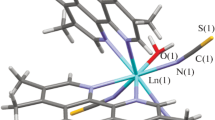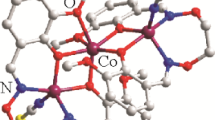Abstract
p-Tolylmercury selenocyanate and α-naphthylmercury selenocyanate act asLewis-bases towards Co(NCS)2·2C2H5N and form a pink compound of the formula (CH5N)2(SCN)2Co(NCSeHgR)2 (R=p-tolyl or α-naphthyl). On heating this compounds in vacuum, a blue compound (SCN)2Co(NCSeHgR)2 was formed,RHgSeCN gives a similar compound on reaction with Ni(NCS)2. The compounds (SCN)2 M(NCSeHgR)2;M=Co(II), Ni(II) again act asLewis-acids. In theseLewis-acids Co(II) has a tetrahedral geometry whereas nickel(II) has an octahedral environment through elongated axial bondings ofXCN-groups (X=S or Se). The selenocyanate bridging of the typeR-Hg-SeCN-M is present in these monomer compounds which were characterized by elemental analyses, molar conductance, molecular weight, magnetic moment, stability constant (logK) infrared and electronic spectral studies. These physico-chemical studies indicate that thep-tolylmercury selenocyanate is a better donor than the α-naphthylmercury selenocyanate and Ni(NCX)2 is a better acceptor than Co(NCX)2. It has also been observed thatRHgSCN is a better donor thanRHgSeCN. These results are supported by the derivations made from softness parameters.
Zusammenfassung
p-Tolyl-quecksilber-selenocyanat und α-Naphthyl-quecksilber-selenocyanat verhalten sich gegenüber Co(NCS)2·2C5H5N alsLewis-Basen, wobei rosagefärbte Verbindungen der Formel (C5H5N)2(SCN)2Co(NCSeHgR)2 (R=p-Tolyl oder α-Naphthyl) entstehen. Beim Erhitzen dieser Verbindungen im Vakuum entstehen die blauen Komplexe (SCN)2Co(NCSeHgR)2,RHgSeCN gibt eine ähnliche Verbindung mit Ni(NCS)2. Die Verbindungen (SCN)2 M(NCSeHgR)2 mitM=Co(II) oder Ni(II) agieren wieder alsLewis-Säuren. In diesenLewis-Säuren besitzt das Co(II) eine tetraedrische Geometrie, währenddessen Ni(II) wegen der gedehnten axialen Bindungen derXCN-Gruppen (X=S oder Se) eine oktaedrische Umgebung aufweist. In den monomeren Verbindungen, die mittels Elementaranalyse, molarer Leitfähigkeit, Molekulargewichtsbestimmungen, magnetischem Moment, Stabilitätskonstanten (logK), IR und Elektronenspektren charakterisiert wurden, ist eine Selenocyanat-Brücke des TypsR-Hg-SeCN-M vorhanden. Die physikalisch-chemischen Daten zeigen an, daßp-Tolyl-quecksilber-selenocyanat der bessere Donor als α-Naphthyl-quecksilber-selenocyanat und Ni(NCX)2 der bessere Acceptor als Co(NCX)2 ist. Ebenso wurde beobachtet, daßRHgSCN der bessere Donor alsRHgSeCN ist. Diese Resultate werden mittels HSAB-Parameter unterstützt.
Similar content being viewed by others
References
Berbieri R., Bjerrum J., Acta Chem. Scand.19, 469 (1965).
Schwazenbach G., Schallenberg M., Helv. Chim. Acta49, 28 (1965).
Singh P. P., Kumar Subir, Reddy M. P., Inorg. Chem.20, 2711 (1981).
Beattie R., Whitemore F. C., J. Amer. Chem. Soc.55, 1567 (1933).
Singh P. P., Yadav D. D. S., J. Mol. Struct.53, 225 (1979).
Turco A.,Pecile C.,Nicolini M., J. Chem. Soc.1962, 3008.
Clark R. J. H., Williams C. S., Spectrochim. Acta.22, 1081 (1966).
Nelson S. M., Shepherd T. M., J. Inorg. Nucl. Chem.27, 2123 (1965).
Forster D., Goodgame D. M. L., Inorg. Chem.4, 823 (1965).
Gearg W. J., Coord. Chem., Rev.7, 81 (1971).
Burmeister J. L., Williams L. E., Inorg. Chem.5, 1113 (1966).
Makhija R.,Beauchamp A. L.,Rivest R., J. Chem. Soc.1972, 1043.
Canty A. J., Marker A., Inorg. Chem.15, 425 (1976).
Pearson R. G., J. Chem. Educ.45, 643 (1968).
Bailey R. A., Kozak S. L., Michelsen T. W., Mills W. N., Coord. Chem. Rev.6, 407 (1977).
Underhill A. E., Billing D. E., Nature210, 835 (1966).
Singh P. P., Gupta A. K., Inorg. Chem.17, 1 (1970).
Klopman G., J. Amer. Chem. Soc.90, 223 (1968).
Singh P. P., Srivastava S. K., Srivastava A. K., J. Inorg. Nucl. Chem.42, 521 (1980).
Huheey J. E., Inorg. Chem. Principles of Structure and Reactivity, p. 229. New York: Harper and Row. 1972.
Author information
Authors and Affiliations
Rights and permissions
About this article
Cite this article
Singh, P.P., Atrey, K. & Yadav, D.S. Study of comparativeLewis-base behaviour ofp-tolyl mercury selenocyanate and α-naphthylmercury selenocyanate. Monatsh Chem 116, 177–187 (1985). https://doi.org/10.1007/BF00798453
Received:
Accepted:
Issue Date:
DOI: https://doi.org/10.1007/BF00798453




